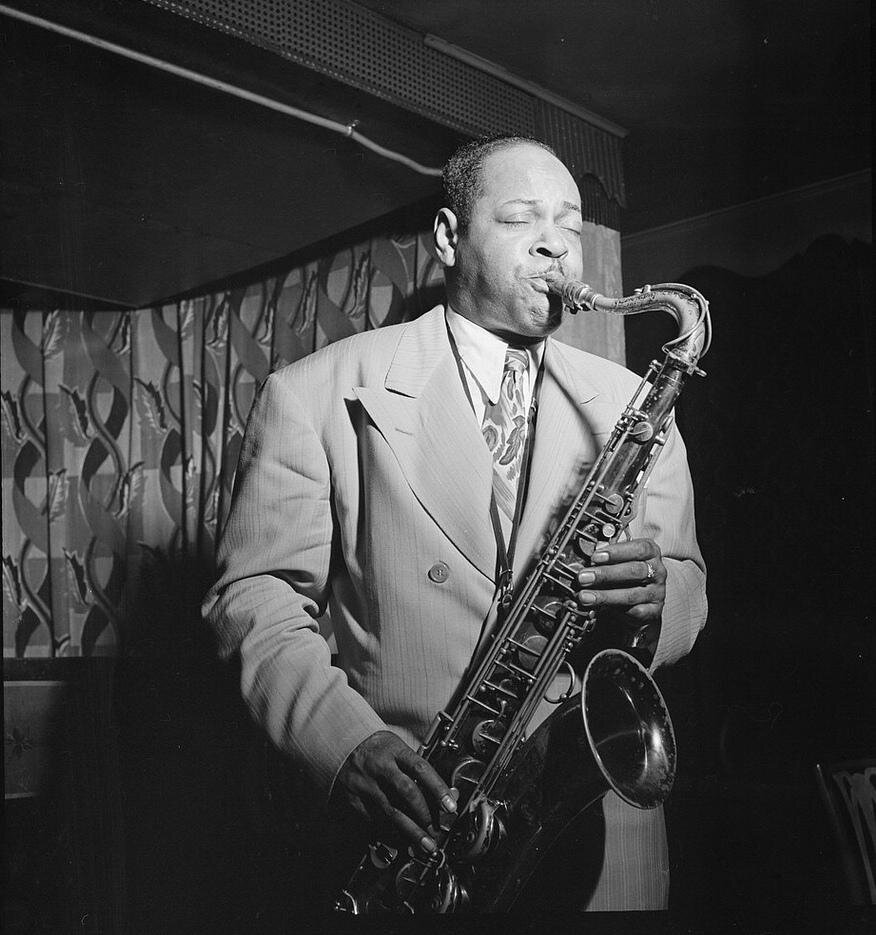
Notable Services
Alvin Ailey was born in Rogers, Texas on January 5, 1931 and moved to Los Angeles, California at the age of twelve. There, on a junior high school class trip to the Ballet Russe de Monte Carlo, he fell in love with concert dance. Inspired by performances of the Katherine Dunham Dance Company and classes with Lester Horton, Mr Ailey began his formal dance training. It was with Mr. Horton, the founder of the first racially integrated dance company in this country, that Mr. Ailey embarked on his professional dance career.
In 1958, Mr. Ailey founded his own company, the Alvin Ailey American Dance Theater. Throughout his lifetime, Mr. Ailey created some 79 ballets, many of which have appeared in the repertoire of major dance companies, including American Ballet Theatre, The Joffrey Ballet, Dance Theatre of Harlem, Paris Opera Ballet and La Scala Ballet.
James Baldwin, whose passionate, intensely personal essays in the 1950's and 60's on racial discrimination in America helped break down the nation's color barrier, died of cancer last night at his home in southern France. He was 63 years old.
Mr. Baldwin published his three most important collections of essays - ''Notes of a Native Son'' (1955), ''Nobody Knows My Name'' (1961) and ''The Fire Next Time'' (1963) - during the years when the civil-rights movement was exploding across the American South
Over a sixty-plus year career, William “Count” Basie helped to establish jazz as a serious art form played not just in clubs but in theaters and concert halls. He established swing as one of jazz’s predominant styles, and solidified the link between jazz and the blues. Compared to the more complex, almost symphonic compositions and arrangements of some of the other leading bandleaders and composers of his time, most notably Duke Ellington and Fletcher Henderson, the Basie band’s arrangements were usually straightforward “head arrangements,” based on a simple riff or melody (the “head”) made up and memorized by the band in rehearsal, and later played in performance as the background for soloists.
Basie won nine Grammy Awards, including two trophies at the very first Grammy ceremony on 1959.
Adolph Caesar Adolph Caesar was born in the Harlem section of New York City. He joined the Navy and then studied drama at New York University. He became an announcer for and subsequently joined the Negro Ensemble Co. in 1970. He performed for such productions as "The River Niger", "Square Root of the Soul" and "The Brownsville Raid." Caesar worked with repertory groups such as the Minnesota Theater Co., Inner City Repertory Co., and the American Shakespeare Co. Caesar first appeared on the screen in CHE (1969). He had parts in low-budget films including The Hitter (1979), Fist of Fear, and Touch of Death (1980) before achieving his greatest success in A Soldier's Story (1984), which earned him an Oscar nomination. Caesar also appeared in The Color Purple (1985).
Arthur Mitchell was born on March 27, 1934 in New York City, New York, USA as Arthur Adams Mitchell Jr. He is known for his work on Dance Theatre of Harlem: Fall River Legend (1989), Playhouse 90 (1956) and A Midsummer Night's Dream (1967). He died on September 19, 2018 in Manhattan, New York City. He founded (along with the late Karel Shook) the Dance Theatre of Harlem in 1969. He is a dancer and choreographer. He was awarded the American National Medal of the Arts in 1995 by the National Endowment of the Arts in Washington D.C.
Lawyer Basil Alexander Paterson was born on April 27, 1926, in Harlem, New York. Paterson’s mother Evangeline Rondon was a secretary for Marcus Garvey. Paterson received his high school diploma in 1942 from De Witt Clinton High School in the Bronx neighborhood of New York City. After working for six months, Paterson entered St. John’s College from which he received his B.S. degree in biology in 1948, having spent two years in the Army. Paterson entered St. John’s Law School and received his J.D. degree in 1951. Paterson then began his professional career as a lawyer in Harlem where he became law partners with Ivan A. Michael and former New York City Mayor David Dinkins. Paterson and Dinkins became heavily involved in Democratic politics in Harlem, along with former Manhattan Borough President Percy Sutton, and Congressman Charles Rangel.
Although he played an instrument more closely identified with uptown concert halls than downtown jazz clubs, there was no mistaking the primary source of Billy Bang's musical inspiration. While his violin technique was extensive and his familiarity with contemporary classical forms apparent, Bang's rough-edged, sometimes almost guttural tone, old-fashioned sense of swing, and lexicon of vocalic expressive devices defined him as a jazz musician. Bang improvised lines that might have been lifted straight from a George Crumb composition, yet he invested them with an emotionalism and spontaneity unique to jazz. Whether in the abstract (as a solo violinist, elaborating on skeletal melodic material) or as part of a greater whole (with Sun Ra's Arkestra, for example), a Bang performance was always awash
with surprise.
The American jazz musician Coleman Hawkins (1904-1969) transformed the tenor saxophone from a comic novelty into jazz's glamour instrument. He was one of the music's all-time preeminent instrumental voices.
Coleman Hawkins was born on November 21, 1904, in St. Joseph, Missouri. His mother, an organist, taught him piano when he was 5; at 7, he studied cello; and for his 9th birthday he received a tenor saxophone. By the age of 12 he was performing professionally at school dances; he attended high school in Chicago, then studied harmony and composition for two years at Washburn College in
Topeka, Kansas.
Phyllis A. Harrison
Commissioner Dr. Phyllis Harrison-Ross, a pioneering black pediatrician, psychiatrist, prison monitor and mental health administrator, died on Jan. 16 in Manhattan. She was 80.
Commissioner Dr. Harrison-Ross was a ubiquitous presence in the mental health field in New York and nationally for more than 35 years. She was an early leader in designing rehabilitation and therapy for children with a combination of severe developmental, emotional and
physical disabilities.
Etta Jones
Etta Jones, a great and permanently underrated jazz singer who for three decades toured constantly with her musical partner, the saxophonist Houston Person, died on Tuesday at her home in Mount Vernon, N.Y. She was 72.
Born in Aiken, S.C., and reared in Harlem, Ms. Jones early on developed wily devices for a small voice. She used silence, the sound of the breath, a quick yodel here and there, lyric readings that drew out or shut down syllables idiosyncratically, and a sliding pitch that made her an extraordinary blues singer. Billie Holiday was the most obvious and famous precedent for her style, and she was capable of astonishingly close Holiday impersonations, though she rarely let her audiences hear them.
George Jackson
George Jackson, who grew up in Harlem to become a movie producer, record company executive and Internet company founder, died yesterday at St. Luke's Roosevelt Hospital. He was 42.
For the last year, Mr. Jackson and his partners had been working in a loft on West 26th Street in Manhattan to create a series of Web sites, called the Urban Box Office Network, aimed at minorities. The first of the Internet sites is expected to go online on Feb. 29. An article in the company's newsletter said that Mr. Jackson had a ''25-hour-a-day dedication'' to the Internet venture.
Gil Nobel
Gil Noble, a television journalist who hosted “Like It Is,” an award-winning Sunday morning public affairs program in New York, one of the longest-running in the country dedicated to showcasing black leadership and the African-American experience, died on Thursday in a hospital in Wayne, N.J. He was 80.His interviews comprised a veritable archive of contemporary black history in America: hundreds of hourlong conversations with political and cultural figures like Lena Horne, Fannie Lou Hamer, Bill Cosby, Sammy Davis Jr., Muhammad Ali, Andrew Young, Dizzy Gillespie and Stokely Carmichael.
Langston Hughes
James Langston Hughes was born February 1, 1902, in Joplin, Missouri. It was in Lincoln, Illinois, that Hughes began writing poetry. Following graduation, he spent a year in Mexico and a year at Columbia University. In November 1924, he moved to Washington, D.C. Hughes's first book of poetry, The Weary Blues, was published by Alfred A. Knopf in 1926. He finished his college education at Lincoln University in Pennsylvania three years later. In 1930 his first novel, Not Without Laughter, won the Harmon gold medal for literature. Hughes is particularly known for his insightful, colorful portrayals of black life in America from the twenties through the sixties. He wrote novels, short stories and plays, as well as poetry. His life and work were enormously important in shaping the artistic contributions of the Harlem Renaissance of the 1920s.
Kenneth Bancroft Clark
Kenneth Bancroft Clark was an African American psychologist who along with his wife Mamie Clark founded the Northside Center for Child Development in Harlem. They were known for their 1940s experiments using dolls to study children's attitudes about race.
He was born in the Panama Canal Zone where his father worked as an agent for the United Fruit Company. When he was five, his mother took him and his younger sister to U.S. to live in Harlem in New York City.
Kenneth Clark became the first African American tenured full professor at the City College of New York in 1960, and later was the first African American on the New York State Board of Regents and the first African American to be president of the American Psychological Association.
Malik Sealy
A native of the Bronx, New York, Sealy was named after noted African-American social activist Malik Shabazz, better known as Malcolm X, for whom Sealy's father had been a bodyguard. In his senior year at Tolentine High School, Sealy, along with future collegians Brian Reese, and Adrian Autry, went 30-1 and won the state title. Sealy played college basketball at St. John's University, finishing his college career with 2,401 points, good for second all-time in St. John's history. Sealy was drafted by the Indiana Pacers with the 14th overall pick in the 1992 NBA Draft. He has a son named Erik Sealy who is an all American senior at Scottsdale Christian academy.
Over the course of his NBA career, Sealy averaged 10.1 points per game in 23.8 minutes. His final season's highlights included making a game-winning reverse putback shot at the buzzer against the Orlando Magic on December 27, 1999, which gave the Timberwolves a 107–105 road win. He also made a game-winning 3-pointer off the glass as time expired in a 101–100 Timberwolves win over the Indiana Pacers on January 17, 2000.
Matthew Henson
Matthew Henson on August 8, 1886. When Matthew was 13 he took a position as a cabin boy on a merchant ship. In the next five years he traveled the world while learning everything he could about seamanship. But, due to the racism and prejudice he experienced from white sailors, he left his life at sea when he was 18.
Each expedition over the next two decades started from Greenland. He learned everything necessary from the native Innuit to live in the extreme climates of this hostile environment. In turn, he was responsible for training each member of the expedition including Commander Peary.
Finally, on April 7, 1909 Peary, Henson and several Innuit reached the North Pole.
Dr. John Henrik Clark
Dr. John Henrik Clarke was a Pan-Africanist writer, historian, professor, and a pioneer in the creation of Africana studies and professional institutions in academia starting in the late 1960s.
Born John Henry Clark on January 1, 1915, in Union Springs, Alabama, John left the family farm in Columbus in 1933 to Harlem, New York during the period some historians refer to as; The Great Migration. This period refers to the time during 1910 and 1970, where African Americans moved from the southern states, to the northern states in search of work and a better quality of life.
There he pursued scholarship and activism. He renamed himself as John Henrik, after the rebel Norwegian playwright Henrik Ibsen and added an “e” to his surname, spelling it as “Clarke.” The reasoning for this is unknown, as John did not document this change in any of his personal diaries.
George Bernard Benta
George Bernard Benta was born on September 3, 1921 in New York City, the second child of George Alexander and Margaret Jane Sharry Benta. Margaret Benta passed away when Bernard (as he was called) was 3 years old. His father then married Helena Frye Benta, who helped him raise his children and was lovingly referred to as "Aunt Helen." Bernard attended Frederick Douglas Jr. High School, PS 139 where the famed writer Countee Cullen was his teacher. (In later years Bernard proudly told of how Countee Cullen referred to him as brother Bente.) He received his high school education at Textiles High School. At 17, although he was not legally old enough, (fibbed about his age) he enrolled in the 369th infantry, and became a proud member of the National Guard. He later joined the United States Army where he ascended to the rank of Corporal. During his tour of duty he was initially stationed in Oswego, New York and was transferred to Hawaii after the tragic bombing of Pearl Harbor. He was later sent to Okinawa but was discharged a couple of weeks after his arrival. He served in World War II from 1941 to 1945. After receiving an honorable discharge from the Army, Bernard returned to New York and worked in the U.S. Post Office with his father. Shortly thereafter, Bernard's father left the postal service to begin the family business with a partner in 1928. The business was known as Reed and Benta Funeral Home, Inc located on 135th Street. Bernard, always wanting to make his father proud and follow in his footsteps, attended the New York School of Embalming and Restorative Arts, and became a licensed funeral director.
Norma Miller
Known to many as the Queen of Swing, Norma Miller was an author, choreographer, dancer, comedian and actor whose career spanned over seven decades. Discovered at the age of twelve by the Savoy Ballroom's legendary dancer Twist Mouth George, Ms. Miller was been in show business ever since.
Honored with a 2003 National Heritage Foundation Fellowship from the National Endowments of the Arts for her role in creating and continuing to preserve "the acrobatic style swing dance, known as the Lindy Hop," Ms. Miller was an inspiration to all who knew her.
Ornette Coleman
Ornette Coleman, the lightning rod. The most polarizing figure in the history of jazz. The alto saxophonist who outwitted segregation to hit the scene in 1959 and turn the music world on its head. Bursting through bebop and inventing harmolodics, a sound flowing with the unpredictable rhythms of being. He was called rebellious, disruptive, a fraud, thrown off band stands, horn mangled, shunned by his peers, rejected. Choosing to leave the music scene for long stretches, insisting his music be heard on concert stages and not restricted to small smoky basements. Knowing the cost of being a free thinker. He was guided by his harmolodic philosophy of love and expressing life’s surprises through art. Born in Texas, on March 9,1930, he is now called a genius, an icon, a legend, known as one of the most important figures in the history of music. One who is admired by artists across all genres for his convictions, the fight for freedom of creativity and to be one’s self. Ornette passed away in June 2015 at age 85; but his harmolodic song goes on.













































